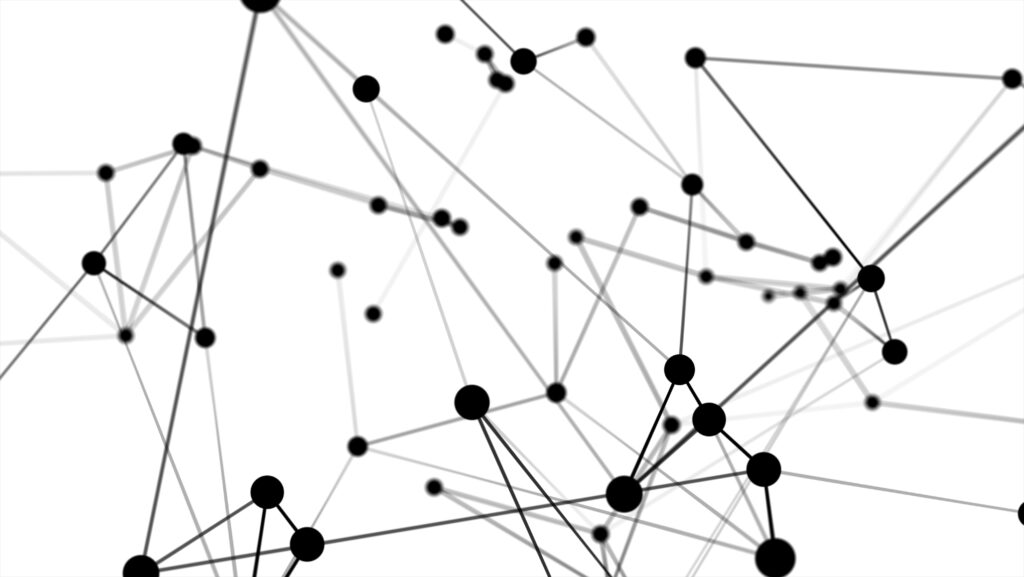Legal reasoning relies on seeing connections between cases, statutes, principles, and facts that others might miss.
Knowledge graphs, the sophisticated data structures now powering advanced legal AI, digitize these connections in ways that mirror how attorneys actually think. While traditional legal databases organize information linearly, legal knowledge graphs create multidimensional webs of legal relationships that enable more sophisticated analysis. These technologies are transforming work across practice areas, from litigation to transactions to compliance.
Understanding how these systems work, and how they differ from traditional legal databases, is becoming essential for attorneys navigating this technological shift.
What Are Legal Knowledge Graphs?
A legal knowledge graph functions as a comprehensive digital network that captures legal concepts and their intricate relationships in a way that mirrors legal reasoning.
Unlike conventional databases with their rigid tabular structures, knowledge graphs create rich webs of interconnected legal concepts, documents, and relationships that facilitate sophisticated analysis.
When attorneys research complex issues, they naturally consider multiple factors simultaneously — relevant cases, statutes, jurisdictions, timelines — and how these elements interrelate. Knowledge graphs digitize this web of relationships, enabling AI systems to navigate legal information with similar conceptual agility.
Core Components
Legal knowledge graphs consist of three fundamental elements:
- Entities: These are the nodes in the graph representing discrete legal elements:
- Cases and statutes
- Legal principles and concepts
- Courts and jurisdictions
- Parties and judges
- Organizations and individuals
- Relationships: These connections between entities capture legal relationships:
- Citations and references
- Interpretations and amendments
- Jurisdictional hierarchies
- Temporal sequences
- Logical dependencies
- Attributes: These properties provide additional context about entities and relationships:
- Filing dates and deadlines
- Jurisdictional information
- Citation counts and precedential value
- Confidence scores
- Status information
How Knowledge Graphs Enhance Legal AI
The rapid evolution of sophisticated language processing systems has dramatically expanded what’s possible in legal technology, creating both opportunities and challenges for practitioners.
Knowledge graphs significantly improve legal AI systems by providing contextual understanding, enhanced reasoning capabilities, and built-in quality assurance mechanisms.
Contextual Understanding
Knowledge graphs help AI systems grasp legal concepts with appropriate nuance and context.
They map hierarchical relationships between legal principles, recognize jurisdictional boundaries and authority structures, track the evolution of legal concepts over time, and identify implicit connections between related concepts that might not be explicitly linked in source documents.
Enhanced Reasoning
These sophisticated data structures support advanced legal analysis by enabling AI systems to follow chains of legal reasoning across multiple documents.
They can identify relevant precedents based on numerous factors simultaneously, draw logical inferences from existing relationships, and validate legal arguments for consistency and strength.
Quality Assurance
Knowledge graphs contribute to accuracy in legal AI by automatically verifying citations and references, checking jurisdictional applicability of legal principles, validating temporal relationships between documents, and identifying potential conflicts or inconsistencies in legal reasoning. This built-in validation capability helps ensure that AI-generated insights meet the high standards required in legal practice.
Practical Applications in Legal Technology
Modern legal technology products implement knowledge graphs in various sophisticated ways that enhance their capabilities. These implementations transform how attorneys find, analyze, and apply legal information.
Research Platforms
Leading legal research platforms use knowledge graphs to revolutionize how attorneys discover and analyze relevant legal information:
Advanced entity recognition technology automatically identifies legal concepts across vast document collections, recognizes variations in legal terminology, extracts relationships between legal documents, and maps citations and references. This enables attorneys to quickly identify relevant authorities without laborious manual searches.
Semantic search capabilities understand the meaning behind legal queries rather than simply matching keywords. These systems recognize conceptually related terms, provide context-aware results, and rank findings based on relevance and authority. The result is more accurate research that captures the nuance of legal concepts.
Contract Analysis Systems
Knowledge graphs enable sophisticated contract analysis by modeling complex contractual relationships:
In clause analysis, these systems identify standard and non-standard clauses, recognize variations in clause language, map relationships between provisions, and track dependencies between clauses. This provides attorneys with deeper insights into contract structure and potential implications.
For risk assessment, knowledge graph-powered systems identify missing or problematic clauses, detect potential conflicts between provisions, evaluate compliance with standards, and assess jurisdiction-specific requirements. This proactive analysis helps attorneys identify issues before they become problems.
Benefits for Legal Practice
Enhanced Research Efficiency
Knowledge graphs transform legal research by dramatically reducing search time while improving the quality of results. Attorneys can find relevant precedents faster, discover related legal principles automatically, validate legal arguments quickly, and identify jurisdictional requirements efficiently.
Research quality improvements include ensuring comprehensive coverage of relevant authorities, identifying hidden relationships between legal concepts, validating legal reasoning for consistency, and providing confidence scores that help attorneys prioritize their analysis.
Many forward-thinking firms are already using automated legal workflows to handle routine document processing and client intake, dramatically improving operational efficiency.
Better Decision Support
Knowledge graph-based systems enhance legal decision-making through strategic analysis and risk assessment capabilities.
For strategic analysis, these systems can analyze judicial tendencies across similar cases, identify successful argument patterns, evaluate precedential strength of authorities, and in some cases predict likely outcomes based on historical patterns.
Risk assessment features help attorneys evaluate the strength of legal positions, analyze contrary authority that might undermine arguments, assess jurisdictional variations that could affect outcomes, and identify potential challenges to legal theories.
While knowledge graphs significantly enhance legal research and analysis, they should supplement, not replace, attorney judgment. Legal professionals should always validate AI-generated insights against their professional expertise and understanding of specific client circumstances.
Implementation Considerations
Data Quality and Coverage
Successful implementation of legal knowledge graphs requires careful attention to data quality and comprehensive coverage of relevant sources. Organizations must establish regular update and maintenance procedures, quality control protocols, and version control systems to ensure the knowledge graph remains accurate and current.
Integration requirements include compatible data formats between systems, standardized APIs for data exchange, secure data transfer mechanisms, and performance optimization to handle large-scale legal data sets effectively.
Successful implementations often leverage retrieval-augmented generation (RAG) techniques to enhance AI responses with firm-specific knowledge and precedents.
Best Practices for Success
Organizations implementing legal knowledge graphs should establish robust data governance and security frameworks.
Effective data governance includes clear data management policies that define standards and responsibilities, quality control procedures to maintain accuracy, defined update and maintenance protocols, and comprehensive audit trails that document system activities.
Security and access control measures should implement role-based access to protect sensitive information, safeguard confidential client data, maintain compliance with data privacy regulations, and track system usage for security and optimization purposes.
Ethical and Professional Responsibility Considerations
Attorneys using knowledge graph-powered legal AI must navigate several ethical considerations:
Duty of Competence: ABA Model Rule 1.1 requires attorneys to provide competent representation, including understanding “the benefits and risks associated with relevant technology.” This increasingly means understanding AI systems’ capabilities and limitations.
Supervision Obligations: When delegating research or analysis to AI systems, attorneys remain responsible for the work product. Establish verification protocols to ensure AI-generated content meets professional standards.
Confidentiality: Carefully evaluate how knowledge graph systems handle sensitive client information, particularly if using cloud-based solutions. Vendor agreements should explicitly address data security, access controls, and confidentiality obligations.
Avoiding Unauthorized Practice: While AI can enhance attorney capabilities, it should not replace professional judgment. Attorneys must ensure that final legal advice reflects their professional assessment, not merely AI-generated conclusions.
Adoption Roadmap for Law Firms
A phased approach to knowledge graph implementation typically works best:
- Assessment Phase: Identify specific practice areas and use cases that would benefit most from knowledge graph technology.
- Pilot Implementation: Start with a limited implementation in a single practice group to test effectiveness and identify integration challenges.
- Skills Development: Train attorneys on effective use of the system, including how to craft queries, interpret results, and validate outputs.
- Gradual Expansion: Extend to additional practice areas based on lessons learned from the pilot phase.
- Continuous Evaluation: Regularly assess ROI, user adoption, and improvement opportunities.
Current Limitations and Challenges
While knowledge graphs offer tremendous potential, attorneys should be aware of their current limitations:
Precedent Gaps: Even the most comprehensive systems may have incomplete coverage, particularly for specialized practice areas or lower court decisions.
Nuance Understanding: Complex legal reasoning sometimes involves intuitive leaps that current AI systems struggle to replicate. Knowledge graphs improve this but don’t eliminate the gap.
Cost-Benefit Considerations: Implementation requires significant investment in technology, data preparation, and training. Small and mid-sized firms should carefully evaluate ROI timelines.
Integration Complexities: Many firms face challenges integrating knowledge graph systems with legacy platforms, potentially requiring custom development work.
Skill Development Requirements: Effective use requires attorneys to develop new skills in query formulation and result interpretation that differ from traditional legal research methods.
Future Potential
Enhanced Reasoning Capabilities
Next-generation knowledge graphs promise to deliver even more sophisticated reasoning capabilities:
Temporal reasoning features will track legal evolution over time, provide deeper understanding of legislative history, monitor regulatory changes as they occur, and analyze trend patterns that might indicate future developments.
Multi-jurisdictional analysis capabilities will handle complex conflicts of law scenarios, compare requirements across different jurisdictions, track cross-border implications of legal decisions, and analyze international law with greater sophistication.
These advancements represent just the beginning of what’s possible, with emerging AI technologies poised to fundamentally transform how legal work is performed over the next decade.”
Advanced Applications
Future legal AI systems built on knowledge graphs will enable more powerful predictive and compliance applications:
Predictive analytics tools will offer more sophisticated case outcome prediction, comprehensive risk assessment, continuous compliance monitoring, and data-driven strategic planning capabilities. As evidence increasingly takes diverse forms, advanced visual and audio analysis capabilities will be integrated into legal knowledge graphs. This will be supported by the integration of immersive technologies in courtroom strategy and trial work through interactive visualization of complex concepts.
Automated compliance systems will provide real-time regulation tracking across jurisdictions, automatic impact assessment when laws change, proactive alerts about potential compliance issues, and change management tools to implement necessary adjustments.
Conclusion
Legal knowledge graphs are revolutionizing the way attorneys operate by digitizing the intricate web of connections — cases, statutes, principles, and facts — that define legal reasoning.
Unlike the rigid, linear structure of traditional legal databases, these systems mirror how lawyers actually think, enabling faster, more precise research and deeper insights into complex legal issues. Knowledge graphs enhance legal AI with contextual understanding, advanced reasoning, and built-in quality checks, fundamentally transforming practice areas like litigation, transactions, and compliance. For instance, they allow AI to map hierarchical relationships between legal concepts, track their evolution over time, and identify implicit links that might elude even seasoned practitioners, offering a level of conceptual agility that static databases can’t match.
The practical benefits are substantial. Research platforms powered by knowledge graphs cut search time dramatically while surfacing more relevant results. Advanced entity recognition pinpoints legal concepts across vast document sets or semantic search that grasps the intent behind a query, not just the keywords. In contract analysis, they model complex relationships between clauses, flagging risks and dependencies that might otherwise go unnoticed.
Attorneys can validate arguments quickly, uncover hidden precedents, and assess jurisdictional nuances with confidence scores to guide their focus. These tools don’t just save time; they elevate the quality of legal work, ensuring comprehensive coverage and consistent reasoning. This is crucial in a profession where precision is non-negotiable.
But it’s not all smooth sailing. Implementation demands rigorous attention to data quality, comprehensive source coverage, and seamless integration with existing systems. Remember, when legal ethics are concerned, the buck stops with you.
Frequently Asked Questions
Q: How do legal knowledge graphs differ from traditional legal databases?
A: Knowledge graphs capture relationships and context in a way that mirrors legal thinking, unlike traditional databases that store information in rigid structures. While traditional systems primarily use keyword matching, knowledge graphs understand conceptual relationships between legal entities.
Q: What are the main benefits of implementing a legal knowledge graph?
A: Key benefits include faster research, better decision support, enhanced compliance monitoring, and more sophisticated risk analysis. Organizations should evaluate vendor claims and conduct their own assessments to determine potential time savings and effectiveness improvements.
Q: How do knowledge graphs improve AI accuracy?
A: They provide context and relationships that help AI systems understand legal concepts more accurately and make more reliable inferences. The structured nature of knowledge graphs may help reduce certain types of errors found in other AI systems.
Q: What are the main implementation challenges?
A: Major challenges include ensuring data quality, maintaining comprehensive coverage, managing updates, and integrating with existing systems. Firms also report change management and attorney adoption as significant hurdles.
Q: How can law firms get started with knowledge graphs?
A: Start by assessing needs, evaluating available solutions, and developing a clear implementation strategy that addresses data quality and integration requirements. Consider beginning with a specific practice area rather than firm-wide deployment.
Q: How do knowledge graphs integrate with existing legal research platforms?
A: Many vendors offer integration capabilities with platforms like Westlaw, LexisNexis, and Bloomberg Law. This allows attorneys to enhance traditional research with knowledge graph capabilities without abandoning familiar tools.
Q: What ongoing maintenance do these systems require?
A: Knowledge graphs require regular updates to incorporate new case law, regulatory changes, and evolving legal doctrines. Most systems use a combination of automated updates and human review for quality control.





